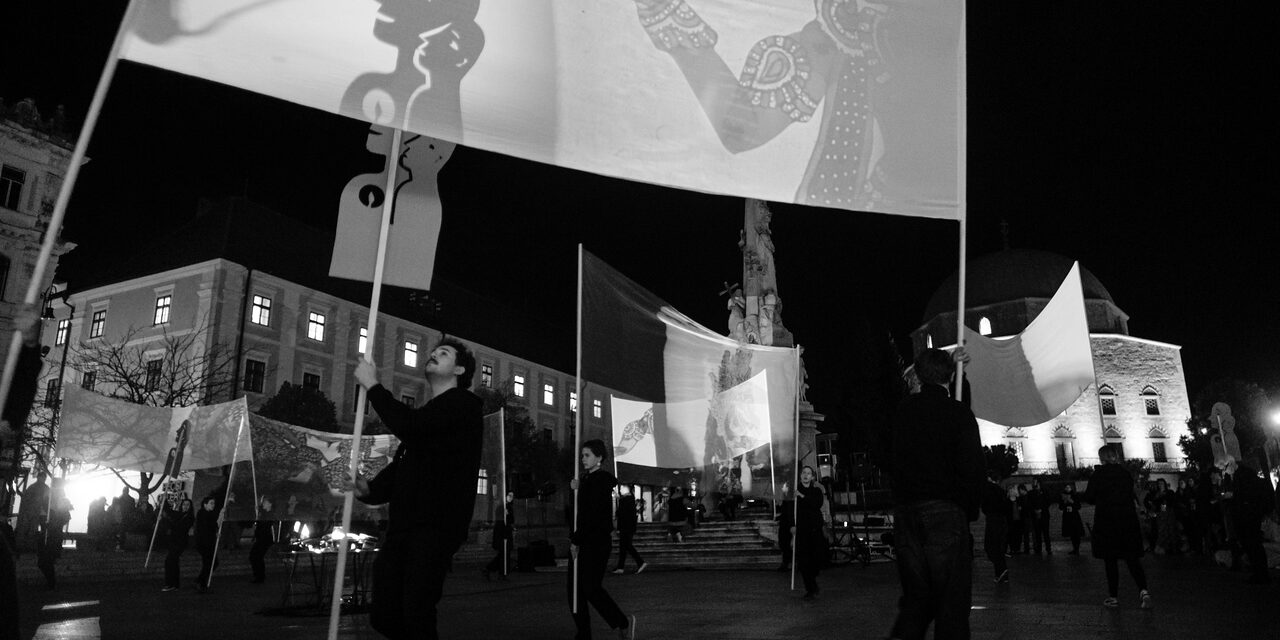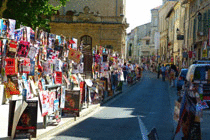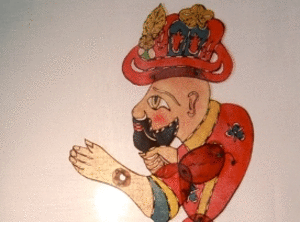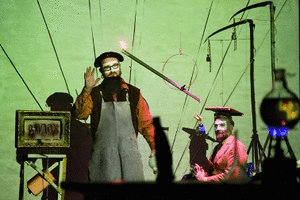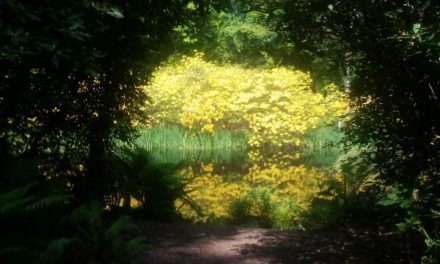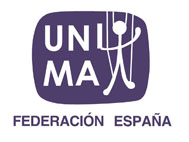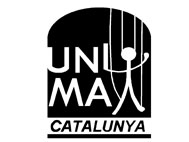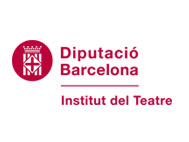Opening ceremony in Szécheny Square with a carousel of projected images, directed by Papír Panír, Hungary. Photo Szenti, Karakulit Festival
Audiences and shadow theatre lovers have had to wait for six years to be able to enjoy for a second time KARAKULIT INTERNATIONAL SHADOW THEATRE festival. But the patience has shown worth it and nobody has been disappointed: In this second edition representatives of shadow theatre from many parts of the world – a total of 12 countries – gathered in Pécs (Hungary) past April to demonstrate that shadow theatre has been present as part of human culture and education for centuries and still has lots of stories to tell!
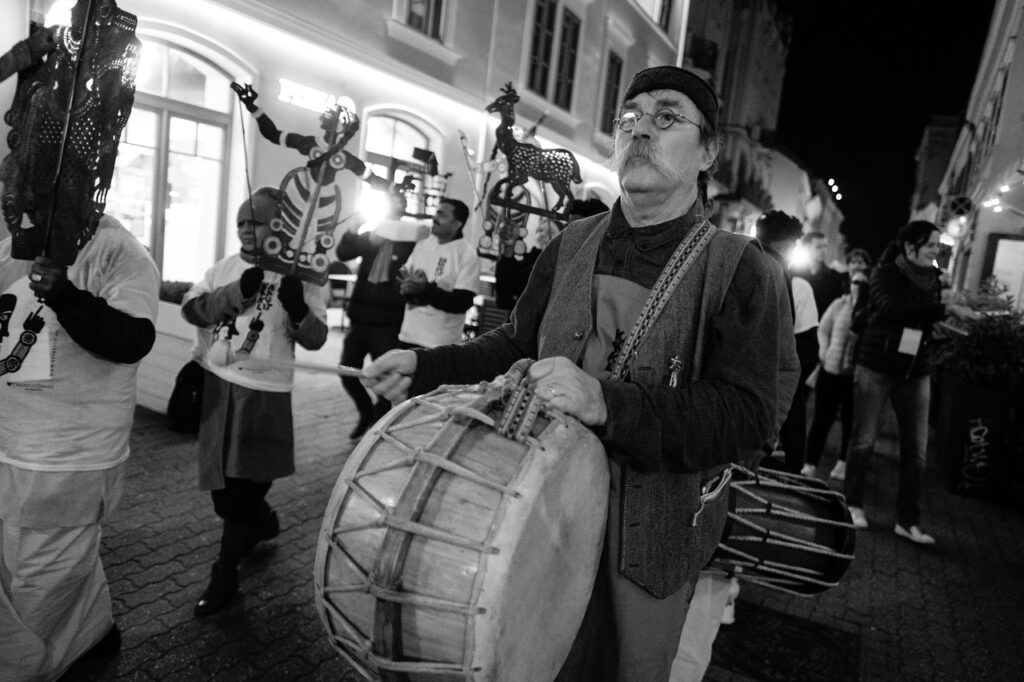
Opening ceremony: parade with Indian silhouettes and puppeteers of the Tholpavakoothu Theatre and music (Gábor Pilári – from Márkus Zínház – in the picture). Photo Szenti, Karakulit Festival
Karakulit Festival is one-of-a-kind: an international festival specific for shadow theatre that counts not only with performances, but also workshops, as well as exhibitions. The festival can not be explained without Márkus Zínház (Márkus Theatre), a family of puppeteers and artists based in Pécs, which is at the heart of the idea and realisation of the festival. Its first edition was born after a dream of this theatre family, shadow lovers and practitioners themselves; after a trip to India where they encountered traditional shadow puppets from Kerala, with the family of Tholpavakoothu Theatre, they dreamt about gathering the greatest traditions of shadow theatre of the world together for Hungarian audiences to enjoy and other professionals to learn from. The trigger to move forward towards such a dream in 2017 was the 500th anniversary of the character of Karagöz, the hero of Ottoman folk shadow theatre; and it was also the reason for half of the naming of the festival (KARA).
It’s well known that shadow tradition belongs to the Asian region, ranging from Karagöz in the Western side (present in Turkey and also Greece) to Wayang Kulit in Indonesia, in the most Eastern end. This lattest kind of puppet contributed to the second part in the naming of the festival (KULIT). Six years later, the framework that made this second edition possible was the 10th Theatre Olympics, a world event that for the first time in this edition included puppetry.
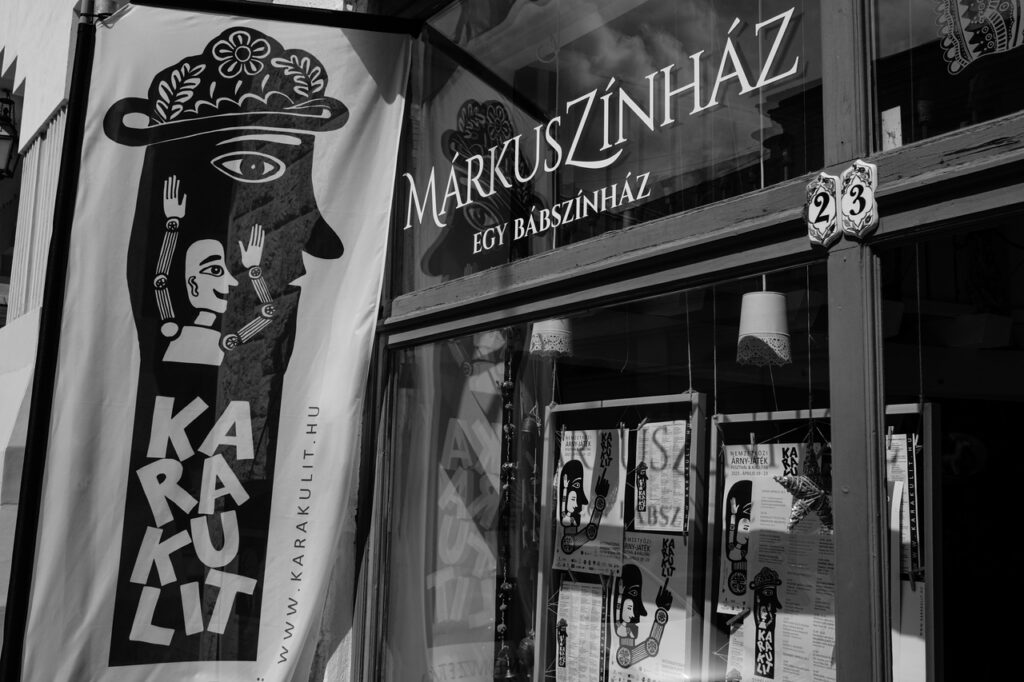
Márkus Zínház – Márkus Theatre, both a place and a family of puppeteers based in Pécs, the soul of the Festival. Photo Szenti, Karakulit Festival
The festival could not be opened in a greater artistic ceremony, shining in all its splendor; a splendor that also had to wait for six full years! Papír Panír (Hungary), as in 2017, was in charge of the ceremony. First edition’s opening was brilliant, but had to be constrained to the walls of Nádor Galéria building due to inclement weather. This edition, started with a two-way parade calling for audiences attention, meeting in the main square of Pécs; then Szécheny square hosted the most striking shadow and light performance: an image projection carousel shone over the square buildings and over two concentric circles of moving cotton screens. And not any image! On the one hand, photographs from traditional puppets which were present in first edition’s exhibitions. On the other hand, a wide variety of life shadows, casted by some of the international companies participating in the festival. The impressive moving lights and shadows were accompanied by the Festival’s theme song playing for the first time, composed by Áron Pilári, one of the members of Márkus Theatre.
This second edition also counted with exhibitions on the topic: from an exhibition with traditional shadow puppets, to photography exhibitions about Hungarian shadow theatre and about the first exhibition.
Thursday 20th April was the first official day of the festival and could have been renamed as the festival itself “karakulit”, since it counted with the performances of both Karagöz by the Greek company Anemodoura Puppet and Shadow Theatre, and Wayang Kulit, by the by the Javanese puppeteer Ki Purbo Asmoro (Indonesia).
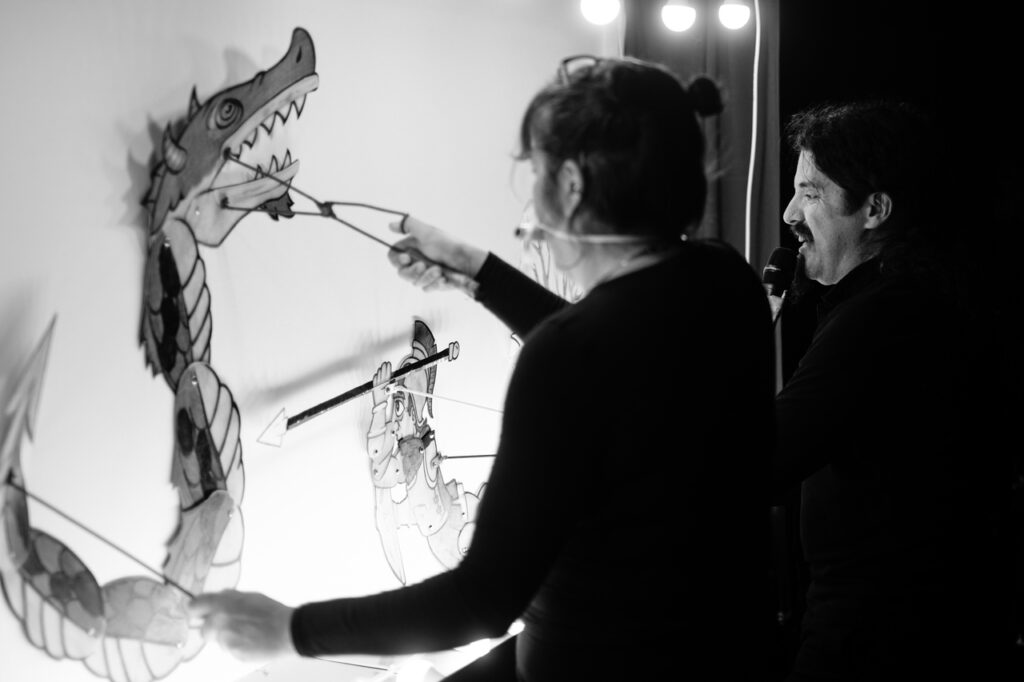
Anemodoura Puppet and Shadow Theatre with “Karagöz and the dragon” (Greece. Foto Szenti, Festival Karakulit
While morning was time for Karagöz, with “Karagiozis and the Dragon”, night was for Wayang Kulit, as it could not have been otherwise: traditional performances usually last all night long – even if a version of over 2 hours was shortened for the festival -. Wayang Kulit performances are also well known to be played only with live music, offered by the traditional orchestra of gamelan, which counts with around 24 musicians. Travelling with such a big team is rarely possible, but Ki Purbo Asmoro brought along 5 of his musicians that were joined by gamelan from the Indonesian embassy in Budapest, Surya Kencana A, for full splendor of the show. The play in Javanese was translated live by Kitsie Emerson, because even if the theme of the play was announced and chosen beforehand, “Bima’s Spiritual Journey”, Javanese puppeteers are prone to improvisation. Such an art of improvisation loves making reference to the reality in each performance, and Ki Purbo Asmoro did not skip mentioning the happiness of the Javanese musicians to be playing along with such a quality gamelan players of non-Indonesian origin.
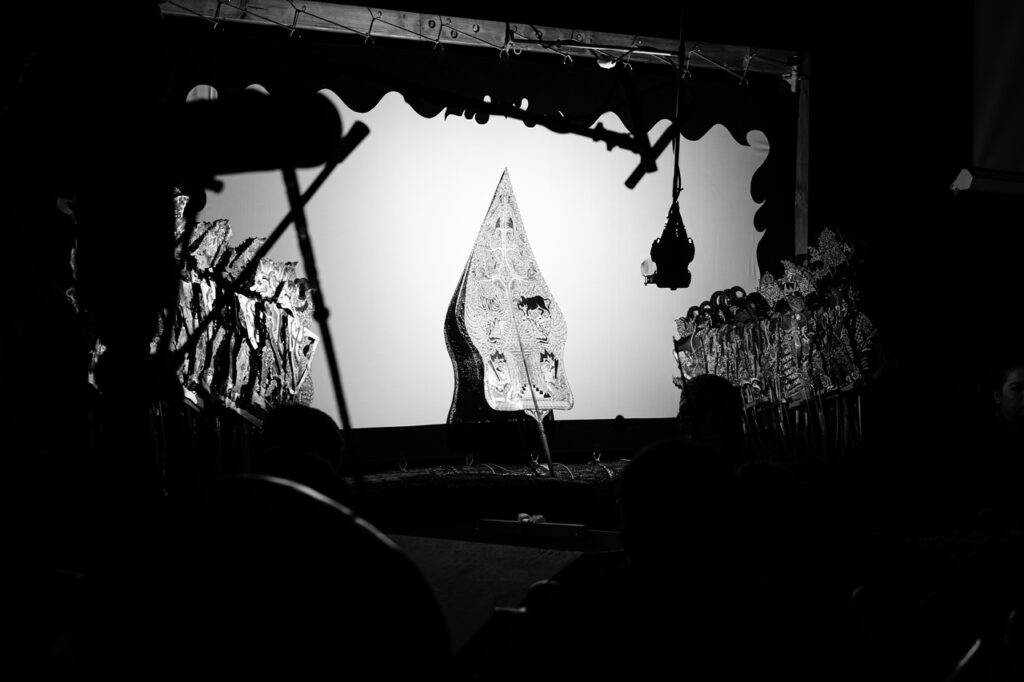
Ki Purbo Asmoro performing with the Javanese wayang kulit (Indonesia) accompanied by the Hungarian gamelan Surya Kencana A. Photo Szenti, Karakulit Festival
And if it was not enough, the first day of the festival counted with another performance from this Southeast Asian country: Wayang Suket Indonesia with “Timun mas” (The Golden Cucumber). Wayang Suket Indonesia group also emphasizes the importance of live music present in Indonesian puppet tradition. However, on this occasion a smaller team (also from Hungary) accompanied the piece, a contemporary performance that contributes to the group’s intention of preventing traditional Wayang Suket (puppets made out of grass) from ending up on the scrap heap of history. The hand-made simple settings projected with overhead projector in contrast with very synthetic but attractive shapes of the grass puppets, fitted well the choice of a folk story. The piece thrilled the audience due to the freshness of the narration, together with very appealing images.
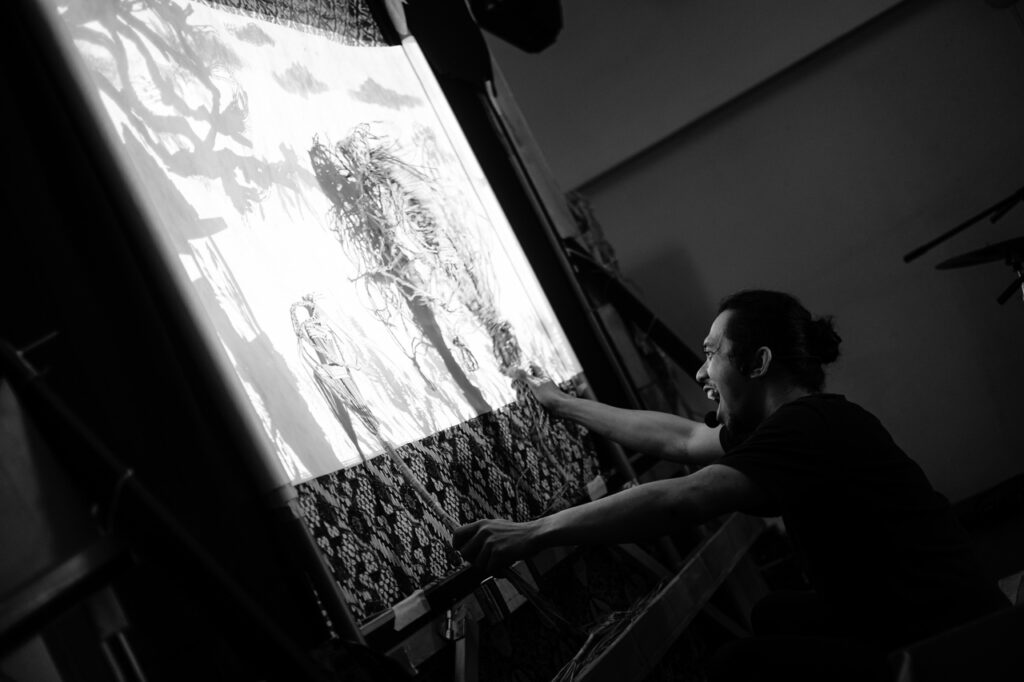
Wayang Suket Indonesia with “The Golden Cucumber”, a folk tale (Indonesia). Photo Szenti, Karakulit Festival
The following morning was occupied with an unplanned workshop for professionals by the Javanese crew, sharing about the moves and tricks of the intricated leather puppets. However, professionals taking part in the festival had a very rich programme that could be followed. Professionals could also enjoy a four-day introductory workshop to shadow theatre run by Italian expert on the topic, Fabrizio Montecchi, as well as other shorter sessions with well-recognised figures in their field.
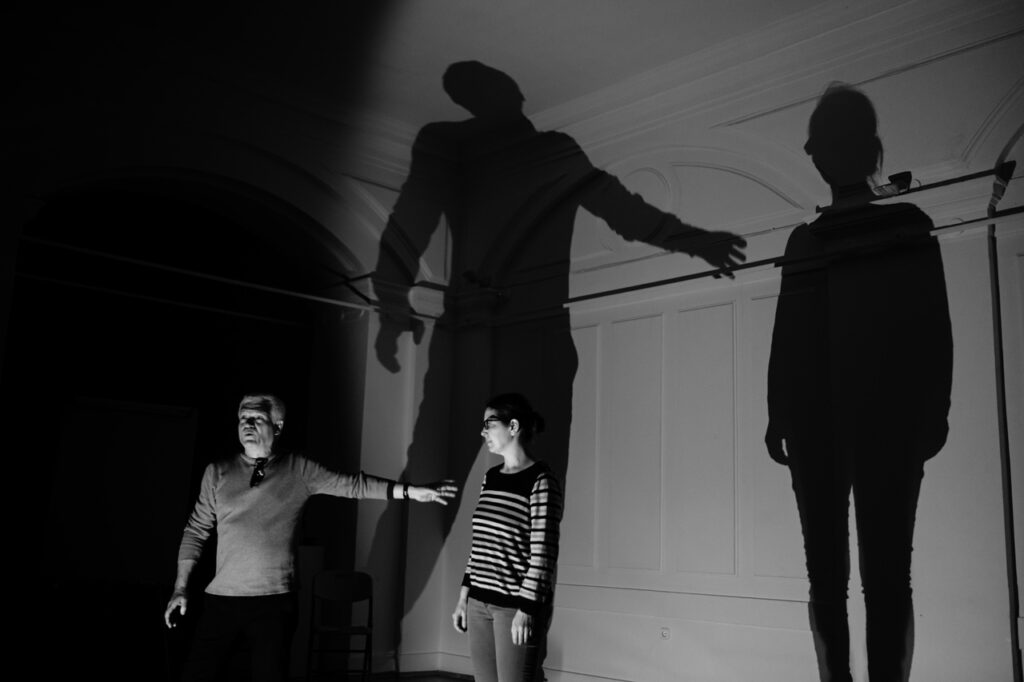
Training for professionals by Fabrizio Montecchi (Italy). Photo Szenti, Karakulit Festival
On the one hand, hand shadow pupeteer Drew Colby from UK, along two different performances, offered a masterclass.
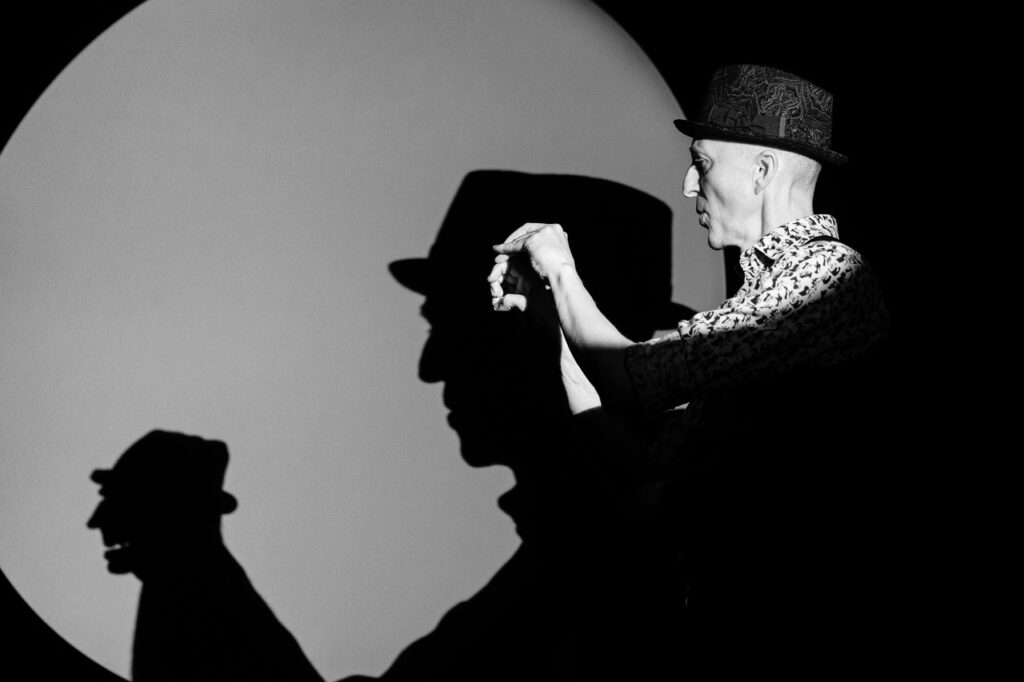
Drew Colby with “Cinema in Silhouettes” (UK). Photo Szenti, Karakulit Festival
On the other hand, Tadeusz Wierzbicki, shared about electrostatic shadows with his latest “exhibition – performance”. Such conceptual workshop (“Gecko’s – Way of Imagination”) opened a new dimension in the possibilities of the shadow play technique, with which the Polish artist has been experimenting for decades; making the most of having such an eminence present, one of the evenings was devoted to his study of movement in a session where documentary films on his experimentation process were shared, as well as the chance to have questions and answers with the artist.
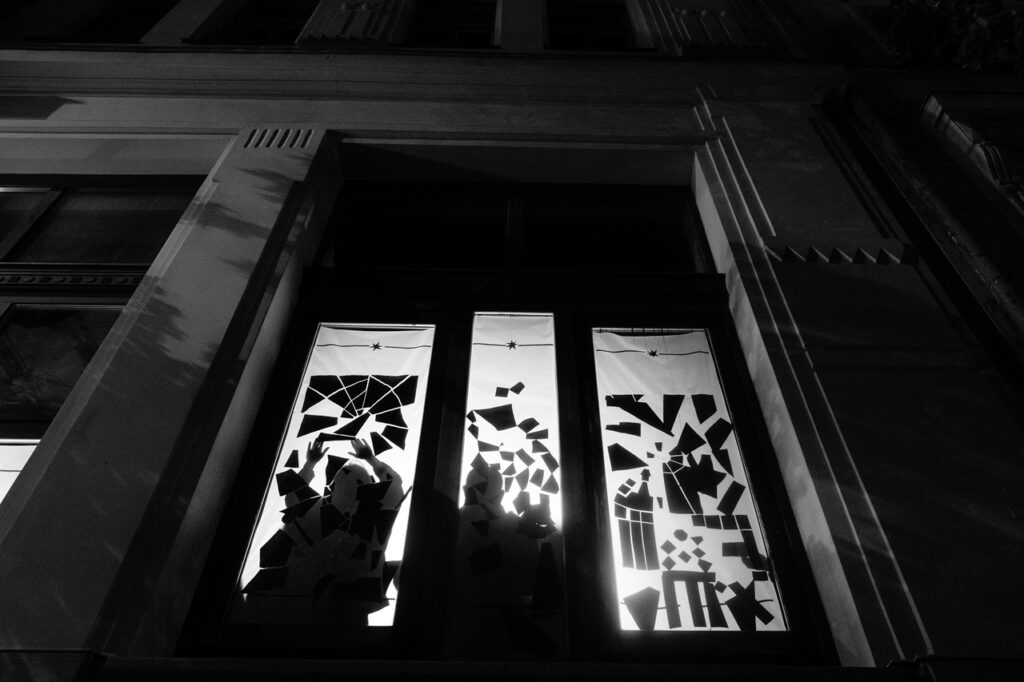
Tadeusz Wierzbicki and his experimental workshop (and exhibition/performance) “The Gecko’s Way of Imagination”. Photo Szenti, Karakulit Festival
Not only the opportunity of such workshops for professionals, but many other clues made clear the real intention, and key, of KARAKULIT FESTIVAL: local audiences are important, but the festival has as its core reason the potential of sharing and learning among professionals. In this edition of the festival, most of the performances had two rounds. One of them, specifically addressed to professionals, when post-performance was as important as the performance itself, the moment for professionals to jump at the back stage and discover the secrets of fellow shadow artists. Thus, KARAKULIT FESTIVAL is one of the few festivals in Europe taking care of the specificity of shadow theatre world, but also the only one with such a focus on the puppeteers! “Traditional and contemporary shadow theatre practitioners find in KARAKULIT an opportunity to inspire each other, get to know each other and make friends”, in the words of Zsuzsanna Vajda, one of the organisers of the festival.
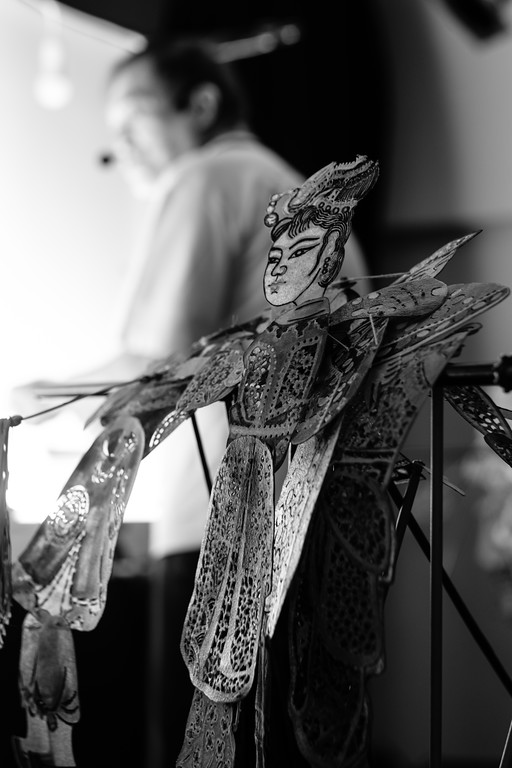
“Legend of the White Snake” by Tung-Hua Shadow Puppet Troupe (Taiwan). Photo Szenti, Karakulit Festival
It is in this after-show moment when interested professionals could get to know the specificities of Taiwanese shadow puppets. Despite the origin in Chinese shadow theatre due to the undeniable connections to this tradition, Tung-Hua Shadow Puppet Troupe puppetmaster proudly tells about the uniqueness of managing with just 2 rods (opposite to the several rods used by Chinese shadow theatre) his turning puppets with walking feet. A great ability by the master (as well as the traditional lighting system) made possible an impressive fighting scene with frenzied transformations from one animal to another of the two characters – the female protagonist fighting a warrior -, which caused constant ooh and aah by the audiences.
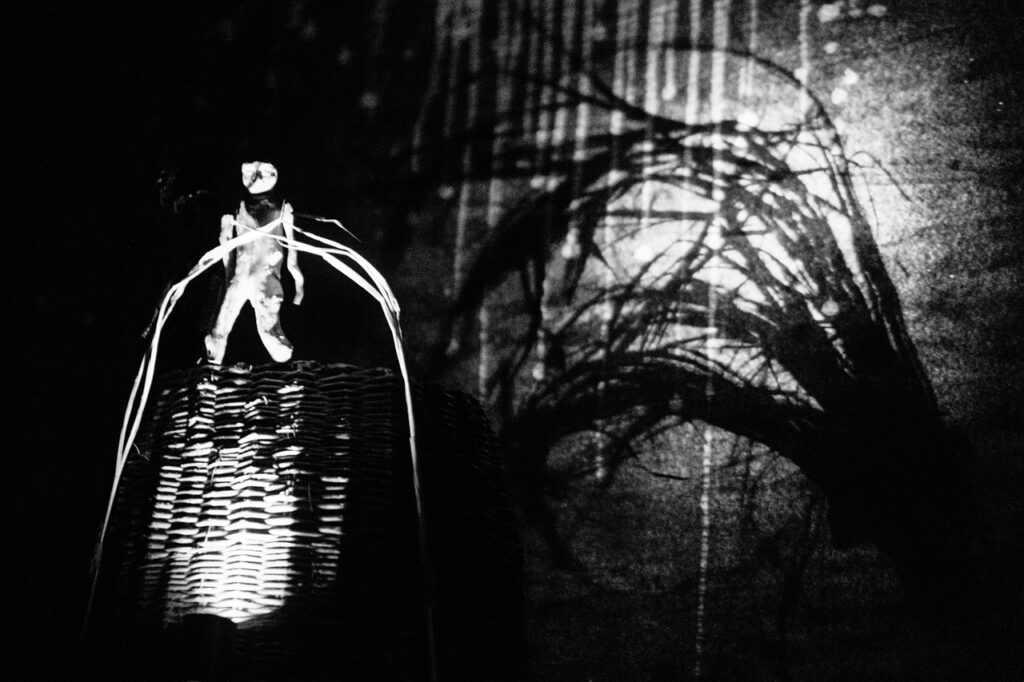
“Bound by grass” by Divadlo Líšeň (Czech Republic). Photo Szenti, Karakulit Festival
In this second edition of the festival, the greatest traditions of shadow puppetry were all present. Some of them, once again, but offering novelty from the first edition: Chinese shadows were present, but from Taiwan and not mainland China; Karagöz too, but the Greek one, not Turkish. Indonesia was present for the first time, and the only traditional shadows seen for a second time were the Indian ones. As far as contemporary shadows are concerned, three of the companies were invited for the second time: the already mentioned master Tadeusz Wierzbicki, who also shared an innovative perfomance with sun shadows, “Diogenes – A Window to the World” (as Teatr “i”), Divadlo Líšeň, company from Czech Republic, and El gecko con botas, from Spain.
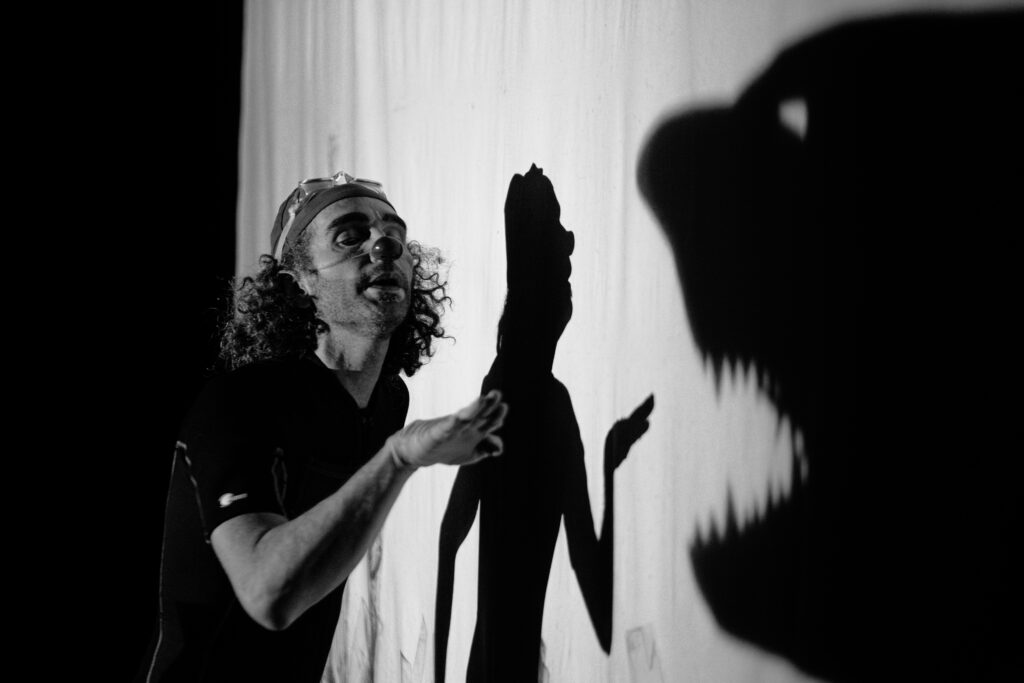
“A pescar!” by El gecko con botas (Spain). Photo Szenti, Karakulit Festival
The performances by the latter two were looked forward to with high expectations after their performances in the first edition. “Bound by Grass” by the Divadlo Líšeň, kept up to the expectations of the professional audience: a play with Budist stories and teachings, performed in coherence with the austerity of the topic using very few objects and only some simple lights and torches casting shadows on a brown-kraft paper screen from both of its sides.
El gecko con botas, with his play on pollution in the seas, “Let’s Go Fishing!”, mixing the language of clownery and shadows (produced by overhead projector and liquids), was very well acclaimed among the family audience.
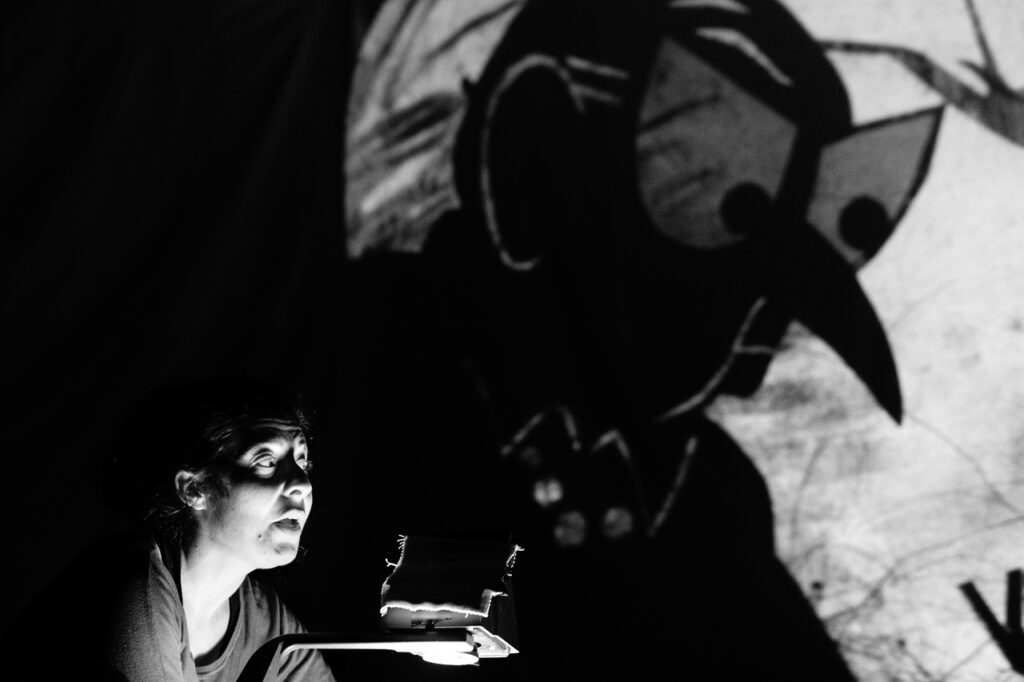
“Eat your berries” by Moquette Production (Belgium). Photo Szenti, Karakulit Festival
But the festival also counted with new companies working with contemporary shadows, and they were a complete success, especially Moquette Production from Belgium. Using overhead projector as well, “Cómete las moras” fue aplaudido por su técnica y uso del humor. “Eat your Brambles” was greatly acclaimed for its technique and use of humor. And Firtosiak, surprised everybody, including organisers: their performance was planned only once in the small Theatre of the organising family, MárkusZínház, but audiences’ high demande made them perform two extra times. Their story is a clear example of what a good Shadow Theatre Festival can provoque. This company from Transylvania, also a family – mother, father and three girls -, attended the first edition of KARAKULIT as audience, and fell in love with shadow theatre. Six years later, the three daughters were puppetiers in the very same festival. Their play “The Tree Promising Heaven”, stole Hungarian audiences’ hearts: a folk story told with detailed cut-outs Reiniger-style, filled in with light magic moments, and life music played by the adult members of the family accompanying their soft singing voices.
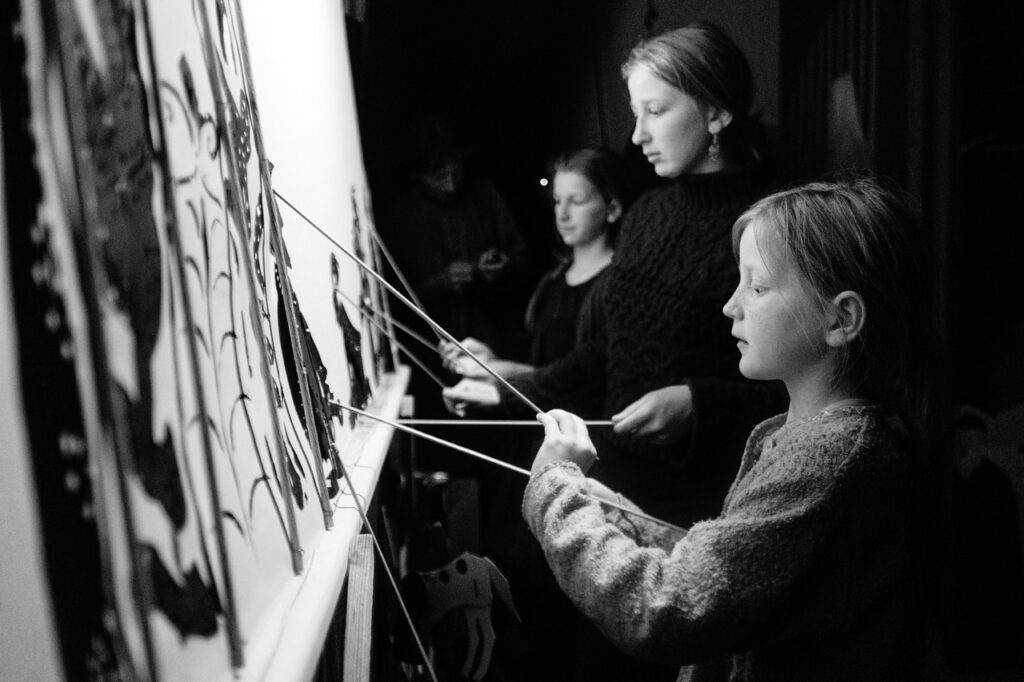
“The tree that promised heaven” from Firtosiak (Transylvania). Photo Szenti, Karakulit Festival
And KARAKULIT FESTIVAL had as the closing performance, the origin of it all (the festival, and probably also shadows): Tholpavakoothu Theatre from Kerala which offered an abridged version of “Ramayana”, with traditional Indian puppets casting shadows thanks to real fire. A school gym in the heart of Hungary hosted the great and unique experience that transported the audience to what could be one of the oldest shadow theatre traditions in the world.
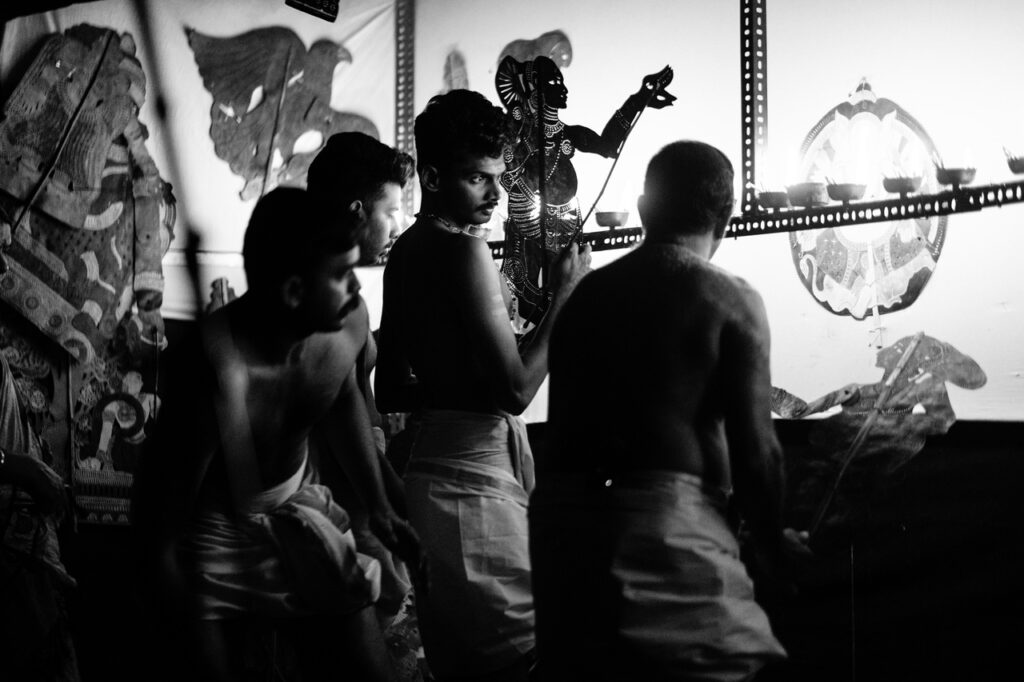
Abridged version of “Ramayana” by Tholpavakoothu Theatre (Kerala, India). Photo Szenti, Karakulit Festival

